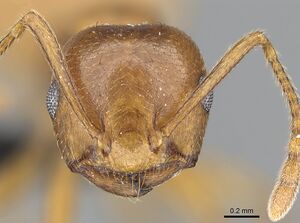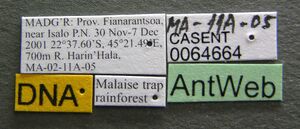Crematogaster bara
| Crematogaster bara | |
|---|---|

| |
| Scientific classification | |
| Kingdom: | Animalia |
| Phylum: | Arthropoda |
| Class: | Insecta |
| Order: | Hymenoptera |
| Family: | Formicidae |
| Subfamily: | Myrmicinae |
| Tribe: | Crematogastrini |
| Genus: | Crematogaster |
| Species: | C. bara |
| Binomial name | |
| Crematogaster bara Blaimer, 2013 | |
Crematogaster bara has a very narrow distribution range in gallery forest, savannah, Uapaca woodland and spiny forest habitat in southwestern Madagascar. It has been collected at elevations from 30 m to 1100 m, and occurs in sympatry with Crematogaster sewellii, Crematogaster dentata and Crematogaster maina. Not much is known about the biology of this species. One collection has been made of a colony nesting under a stone, indicating that this species may be ground-nesting.
Identification
Blaimer and Fisher (2013) - Crematogaster degeeri assemblage. Crematogaster bara is easily distinguished from all other species of the C. degeeri-assemblage by a combination of the following characters: yellow body color, medium to large size (HW 0.87-1.03, WL 0.98-1.22) and very long antennal scapes (SI 0.91-1.01).
Keys including this Species
- Key to Crematogaster degeeri species assemblage workers
- Key to Crematogaster degeeri species assemblage queens
Distribution
Latitudinal Distribution Pattern
Latitudinal Range: -21.13500023° to -22.90367°.
| North Temperate |
North Subtropical |
Tropical | South Subtropical |
South Temperate |
- Source: AntMaps
Distribution based on Regional Taxon Lists
Malagasy Region: Madagascar (type locality).
Distribution based on AntMaps
Distribution based on AntWeb specimens
Check data from AntWeb
Countries Occupied
| Number of countries occupied by this species based on AntWiki Regional Taxon Lists. In general, fewer countries occupied indicates a narrower range, while more countries indicates a more widespread species. |

|
Estimated Abundance
| Relative abundance based on number of AntMaps records per species (this species within the purple bar). Fewer records (to the left) indicates a less abundant/encountered species while more records (to the right) indicates more abundant/encountered species. |

|
Biology
Castes
Males have yet to be collected.
Worker
Images from AntWeb
   
| |
| Holotype of Crematogaster bara. Worker. Specimen code casent0491123. Photographer Estella Ortega, uploaded by California Academy of Sciences. | Owned by CAS, San Francisco, CA, USA. |
Queen
Images from AntWeb
    
| |
| Queen (alate/dealate). Specimen code casent0064664. Photographer Shannon Hartman, uploaded by California Academy of Sciences. | Owned by CAS, San Francisco, CA, USA. |
Nomenclature
The following information is derived from Barry Bolton's Online Catalogue of the Ants of the World.
- bara. Crematogaster bara Blaimer, in Blaimer & Fisher, 2013b: 20, fig. 7 (w.q.) MADAGASCAR.
- Type-material: holotype worker, 4 paratype workers.
- Type-locality: holotype Madagascar: Fianarantsoa, P.N. Isalo, Ambovo Springs, 29.3 km. N Ranohira, 990 m., 22°19.9’S, 45°21.1’E, 14.ii.2003, BLF07783 (B.L. Fisher et al.).
- Type-depositories: CASC (holotype); MCZC, MHNG, SAMC, UCDC (paratypes).
- Distribution: Madagascar.
Unless otherwise noted the text for the remainder of this section is reported from the publication that includes the original description.
Description
Worker
(n = 16) [holotype] HW 0.87-1.03 [0.96]; HL 0.78-0.95 [0.89]; EL 0.18-0.23 [0.20]; SL 0.77-0.87 [0.83]; WL 0.98-1.22 [1.07]; SPL 0.10-0.18 [0.12]; PTH 0.18-0.24 [0.20]; PTL 0.27-0.34 [0.30]; PTW 0.28- 0.36 [0.31]; PPL 0.15-0.19 [0.16]; PPW 0.28-0.35 [0.29]; LHT 0.77-0.93 [0.82]; CI 1.04-1.14 [1.08]; OI 0.21-0.25 [0.22]; SI 0.91-1.01 [0.93]; SPI 0.09-0.17 [0.12]; PTHI 0.62-0.75 [0.68]; PTWI 0.97-1.17 [1.02]; PPI 1.65-2.00 [1.86]; LBI 1.20-1.32 [1.29]. Medium to large size (HW 0.87-1.03, WL 0.98-1.22).
Masticatory margin of mandibles with four teeth; head shape quadrate, or longer than wide (CI 1.04- 1.14); posterior margin of head in full-face view laterally rounded or subangular; occipital carinae usually distinct; antennal scapes always easily surpassing head margin; midline of eyes situated at midline of head in full-face view; eyes moderately large (OI 0.21-0.25) and protruding. Pronotum laterally subangular to rounded; promesonotal suture indistinct; promesonotum more or less forming one rounded plane, mesonotum usually with a short posterior face; laterally mesonotum angular, ending in minuscule posterolateral denticles that set off the promesonotum from propodeum; metanotal groove shallow, laterally constricted; propodeal spines short, spiniform (SPI 0.09-0.17); propodeal spiracles large, situated directly at base of spines; dorsal face of propodeum convex, almost as long as posterior face; posterior face of propodeum gently sloping; petiole in dorsal view broadly oval or moderately flared, usually concave, without posterolateral tubercules or denticles; subpetiolar process usually present as angular dent; postpetiole very distinctly bilobed, with broad median impression; subpostpetiolar process absent.
Head sculpture reticulate; pronotum dorsally rugulose-reticulate; mesonotum reticulate, mesopleuron areolate, dorsal face of propodeum reticulate-carinulate; otherwise sculpture mostly reticulate; face usually with < six erect, longer setae, and regular, shorter, appressed to decumbent pubescence; erect pilosity on promesonotum usually < eight long setae; otherwise promesonotum dorsally with regular appressed pubescence; petiole and postpetiole usually with a pair of longer erect setae posterolaterally, and shorter decumbent or appressed pubescence; abdominal tergites four to seven with fairly regular, short, erect pilosity, more abundant and longer on sternites four to seven, and abundant appressed pubescence throughout. Color bright to reddish yellow.
Queen
(n = 3) HW 1.42-1.45; HL 1.32-1.37; EL 0.39-0.40; SL 1.03-1.12; MSNW 1.22-1.48; MSNL 1.37-1.44; WL 2.46-2.75; SPL 0.00; PTH 0.37-0.40; PTL 0.44-0.47; PTW 0.55-0.61; PPL 0.37-0.38; PPW 0.59- 0.61; LHT 1.22-1.25; CI 1.06-1.08; OI 0.28-0.31; SI 0.76-0.82; MSNI 0.89-1.07; SPI 0.00; PTHI 0.84- 0.87; PTWI 1.23-1.31; PPI 1.61; LBI 2.12-2.20. Medium size (HW 1.42-1.45, WL 2.46-2.75). With worker characters, except as follows. Masticatory margin of mandibles with five teeth; antennal scapes easily surpassing level of lateral ocelli; eyes fairly large (OI 0.28-0.31), situated at midline of head in full-face view; head shape more or less quadrate (CI 1.06-1.08), posterior margin straight.
Mesoscutum in dorsal view variable (MSNI 0.89-1.07); dorsal face of propodeum short; propodeal tubercules or denticles may be present; petiole moderately flared, postpetiole merely impressed posteriorly; subpetiolar process absent. Head sculpture reticulate; dorsal face of propodeum carinulate; petiole and postpetiole reticulate; otherwise sculpture reticulate throughout; face usually with < ten longer, erect setae and dense, short, erect to decumbent pubescence; mesonotum with regular, short, suberect pubescence, interspersed with longer, erect setae; petiole and postpetiole with dense, short, suberect to decumbent pilosity, and postpetiole with additional, longer dorso-posterior setae; abdominal tergites and sternites four to seven with abundant, short, erect pilosity and dense appressed to decumbent pubescence. Colored yellow as in workers; wings clear.
Type Material
Holotype. Worker: pinned, CASENT0491123, BLF07783, under stone [imaged on AntWeb]; original locality label: MADG’R: Fianarantsoa: P.N. Isalo, Ambovo Springs, 29.3 km 4° N Ranohira 990 m, 22º19.9’S, 45º21.1’E, 14 Feb. 2003, Fisher et al., BLF#; deposited at California Academy of Sciences. Paratypes. 4 workers, pinned, same collection and locality data as holotype. #1: CASENT0317776, deposited at South African Museum. #2: CASENT0317777, deposited at Musee d'Histoire Naturelle Genève. #3: CASENT0317778, deposited at Museum of Comparative Zoology. #4: CASENT0317779, deposited at University of California, Davis. MADAGASCAR: Fianarantsoa: P.N. Isalo, Ambovo Springs, 29.3 km 4° N Ranohira, -22.29833, 45.35167, 990 m, Uapaca woodland.
Etymology
Crematogaster bara is named after the Malagasy “Bara” tribe that inhabits the countryside within the distribution range of this species. The name is treated as noun in apposition.
References
- Blaimer, B.B., Fisher, B.L. 2013. Taxonomy of the Crematogaster degeeri-species-assemblage in the Malagasy region (Hymenoptera: Formicidae). European Journal of Taxonomy 51: 1-64 (doi:10.5852/ejt.2013.51).
References based on Global Ant Biodiversity Informatics
- Blaimer B. B., and B. L. Fisher. 2013. Taxonomy of the Crematogaster degeeri-species-assemblage in the Malagasy region (Hymenoptera: Formicidae). European Journal of Taxonomy 51: 1-64.

